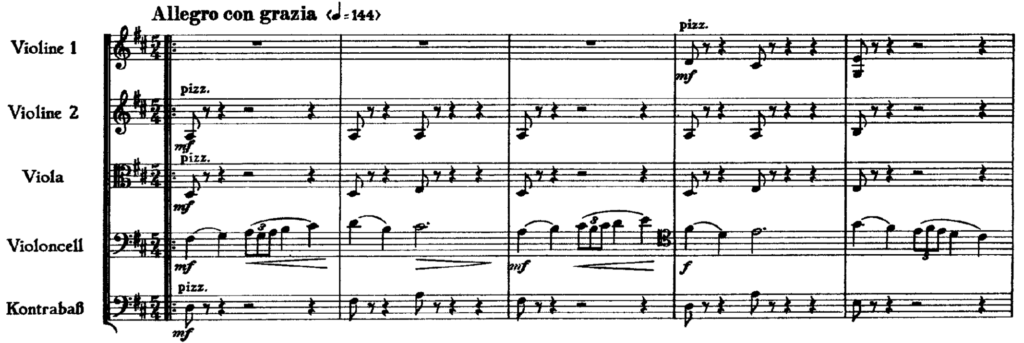Main Body
30 Composite meters
Learning goals for Chapter 30
In this chapter, we will learn:
- The most common types of
- How to conduct and read rhythms using time signatures of composite meters
- How to aurally identify composite meters
Some systems of metric organization can be thought of as a combination or composite of two or more simple duple and triple meters, resulting in unequal, asymmetric beats. We call these or asymmetric meters. The time signatures for composite meters usually feature 5 or 7 as the top number. Other composite meters similarly combine groups of 3 and 2 divisions.
Composite meters with 5 as the top number
When 5 is the top number of a composite meter, the five divisions form two uneven beat groups—either 3 + 2 or 2 + 3. Conducting becomes a modified duple pattern: the beat with three divisions is slightly longer than the beat with two. Example 30‑1 uses a 2 + 3 grouping. Notice how the eighth notes are beamed to show this grouping. Example 30‑2 uses a 3 + 2 grouping, beamed to show a longer first beat followed by a shorter second beat.
Example 30‑1. Sample rhythm in ![]() with 2 + 3 grouping
with 2 + 3 grouping
Example 30‑2. Sample rhythm in ![]() with 3 + 2 grouping
with 3 + 2 grouping
Listen to the 3 + 2 grouping in Dave Brubeck’s famous “Take Five” in Example 30‑3.
Example 30‑3. Paul Desmond, “Take Five,” recorded by the Dave Brubeck Quartet, 0:14–0:35
Listen to the full track on Spotify.
Learn about American jazz saxophonist Paul Desmond (1924–1977) by reading this Oxford Music Online article, written by Max Harrison.
Learn about American jazz composer Dave Brubeck (1920–2012) by reading this Oxford Music Online article, written by Richard Wang.
Listen to the 2 + 3 grouping in Example 30-4. Visual cues that contribute to the interpretation of 2 + 3 can be found in the cello part (labeled in the score as “Violoncell”), particularly in mm. 2 and 4, where the rhythm is two quarter notes followed by a dotted half.
Example 30-4. Pyotr Il′yich Tchaikovsky, Symphony no. 6, op. 74, mvt. 2, mm. 1–5, strings only
Listen to the full movement, performed by the Cincinnati Symphony Orchestra conducted by Paavo Järvi, on Spotify.
Learn about Russian composer Pyotr Il’yich Tchaikovsky (1840–1893) by reading this Oxford Music Online article, written by Roland John Wiley.
Example 30-5 may be interpreted as either 2 + 3 or 3 + 2. The transcription in Example 30-5 shows the rhythm of a pattern that repeats throughout the track. Video R08 demonstrates conducting of the 2 + 3 grouping with this example, but you may conduct in either 2 + 3 or 3 + 2, depending on your interpretation.
Example 30‑5. Radiohead, “15 Step,” 0:00–0:15
Listen to the full track on Spotify.
Learn about English rock band Radiohead by reading this Oxford Music Online article, written by Christopher Doll.
Composite meters with 7 as the top number
When 7 is the top number of a composite meter, the seven divisions form three uneven beat groups—as 2 + 2 + 3 (as shown in Example 30‑6), 3 + 2 + 2 (as shown in Example 30‑7), or the less common 2 + 3 + 2. The conducting pattern for these meters is a modified triple pattern. Again, the beat with three divisions is slightly longer than the two-division beats.
Example 30‑6. Sample rhythm in ![]() with 2 + 2 + 3 grouping
with 2 + 2 + 3 grouping
Example 30‑7. Sample rhythm in ![]() with 3 + 2 + 2 grouping
with 3 + 2 + 2 grouping
Example 30‑8 shows the 2 + 2 + 3 pattern in another recording by Radiohead.
Example 30‑8. Radiohead, “2+2=5,” 0:36–0:52
Listen to the full track on Spotify.
Learn about English rock band Radiohead by reading this Oxford Music Online article, written by Christopher Doll.
Example 30‑9 demonstrates the 3 + 2 + 2 grouping in a song from the musical Jesus Christ Superstar.
Example 30‑9. Trad., “Dance of Zalongo,” opening melody
Listen to the full track, performed by The Plucked String Orchestra Of The Municipality Of Patras on Spotify.
Learn about the Dance of Zalongo by reading this article on the Greek City Times website.
Composite meters with 10 as the top number
When 10 is the top number, most commonly the ten divisions form four uneven beat groups as 3 + 3 + 2 + 2, as shown in Examples 30-10 and 30-11. The conducting pattern for this meter is a modified quadruple pattern.
Example 30‑10. Sample rhythm in 10/8 with 3 + 3 + 2 + 2 grouping
Example 30‑11. Eric Whitacre, “Kalá Kallá” from 5 Hebrew Love Songs, 0:37–0:56
Want more practice? For additional rhythm reading practice, please refer to nos. 100–115 in Appendix A: Rhythm supplement, which contains many short, sight-readable rhythms.
EXERCISE 30-1 Identifying composite meters aurally
First, access the playlist here: Spotify playlist for composite meters
Put the playlist on shuffle, and play up to 60 seconds of any track on the playlist. While listening, in whatever order works best for you, determine how the divisions are grouped, and find the downbeat to try out different conducting patterns. Your ultimate goal is to determine the grouping pattern and top number of the time signature (5, 7, 10, 11, or 13[1]).
Once you have determined the meter type, check your answer with the key here: Answers to EXERCISE 30.1 Identifying composite meters aurally
- There are several bonus examples on the playlist that combine groups of 3 and 2 to create meters in 11 and 13! ↵
system of metric organization that combines two or more simple meters resulting in unequal, asymmetric beats; the most common composite meters have 5 or 7 as the top number in the time signature; also called "asymmetric meters"








